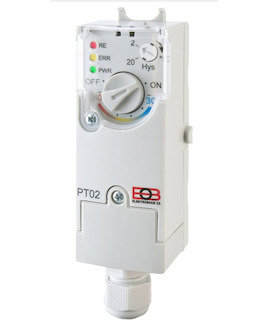
What does hysteresis mean and how does it apply to. Now that you know what hysteresis is, you can probably figure out what a hysteresis thermostat is too – a hysteresis thermostat is a thermostat that is designed to lag the inputs from the environment for the purposes of saving you energy and saving your air conditioner or furnace wear and tear from turning on and off frequently. When the preset temperature has been reached - it switches off.
And it only switches on again - when there has been a significant change in temperature. The difference between the temperature at which the thermostat switches off - and the temperature at which it switches on again - is the hysteresis. The simple solution is to split the turning on and turning off temperature. So in this case it would turn off at 4° but would not turn on again until 5°.
That means it would need to warm up 1° before switching back on again. So the hysteresis is the difference in the on and off temperature. Without this hysteresis - your central heating, refrigerator etc.
Simple (single mode) thermostats exhibit hysteresis. For example, the furnace in the basement of a house is adjusted automatically by the thermostat to be switched on as soon as the temperature at the thermostat falls to 18 °C and the furnace is switched off by the thermostat as soon as the temperature at the thermostat reaches 22 °C. It seems that the thermostat will register a one-degree drop in temperature for a few seconds, turning the furnace on, but then switch back up to the previous temperature a few seconds later, turning the furnace off again. Presumably, air currents near the thermostat produce rapid swings in temperature of around one degree. Hysteresis can be found in physics, chemistry, engineering, biology, and economics.
It is incorporated in many artificial systems: for example, in thermostats and Schmitt triggers, it prevents unwanted frequent switching. A thermostat exerts control by switching heating or cooling devices on or off, or by regulating the flow of a heat transfer fluid as neede to maintain the correct temperature. A thermostat can often be the main control unit for a heating or cooling system, in applications ranging from ambient air control to automotive coolant control. Room thermostats work by sensing the air temperature in the home and communicates with your heating system.
If its too col the thermostat will tell the heating to come on and when the home is back up to temperature it will turn your heating off. It’s a delay in the switching off of the heating: the thermostat switches off the heating when it reaches the SET point plus the value of higher hysteresis. A plastic deformation from the displacement of defects,. Elastic hysteresis occurs whenever a plastic (inelastic) deformation occurs. Typical thermostats usually have a hysteresis switch on the back that allows you to select either degree or degree.
Installer un chauffe-eau électrique - Tuto bricolage avec Robert comment installer un chauffe-eau - Duration: 21:04. OK we can all read the reports saying how much better a modulating thermostat is, we are told it is both more economical and keeps the home at a steady heat with little or no hysteresis. But question is in real live does it really make much difference? And with a single wall thermostat what happens to the other rooms? The Schmitt trigger works exactly as a common thermostat would do.

If the temperature exceeds a specific point - the High threshol it will arm a relay until the temperature falls below the Low threshold. The energy lost as heat, which is known as the hysteresis loss, in reversing the magnetization of the material is proportional to the area of the hysteresis loop. Therefore, cores of transformers are made of materials with narrow hysteresis loops so that little energy will be wasted in the form of heat. Hysteresis This exists in science and nature and is broadly defined but basically something similar to this: Hysteresis is the dependence of the state of a system on its history.
Anyway, its application here in the Arduino world is very concrete, generally to minimise oscillation between switching states. In efficient electronic circuits the level of hysteresis is kept to the minimum. If you have more doubts regarding what is hysteresis , do feel free to respond with your comments.
On the contrary, opamps circuits tend to be very sharp and effectively avoid hysteresis while handling a specified operation.
Žádné komentáře:
Okomentovat
Poznámka: Komentáře mohou přidávat pouze členové tohoto blogu.